Beam Layout Optimisation
LIDDELL; Adam Alexander ; et al.
U.S. patent application number 16/621488 was filed with the patent office on 2020-07-02 for beam layout optimisation. The applicant listed for this patent is Inmarsat Global Limited. Invention is credited to Pavan BHAVE, Adam Alexander LIDDELL, Benjamin MOORES.
| Application Number | 20200212996 16/621488 |
| Document ID | / |
| Family ID | 59358146 |
| Filed Date | 2020-07-02 |
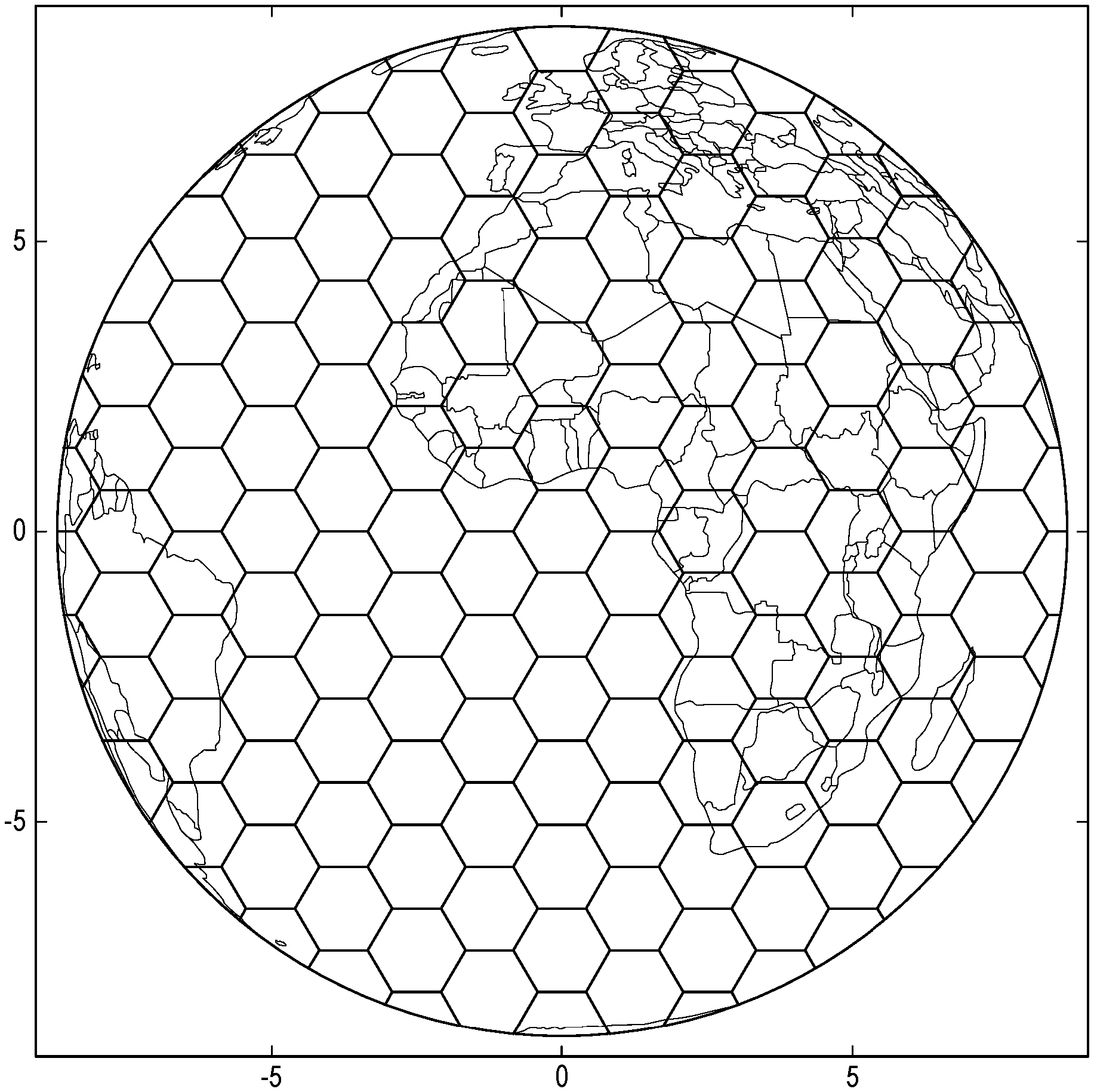
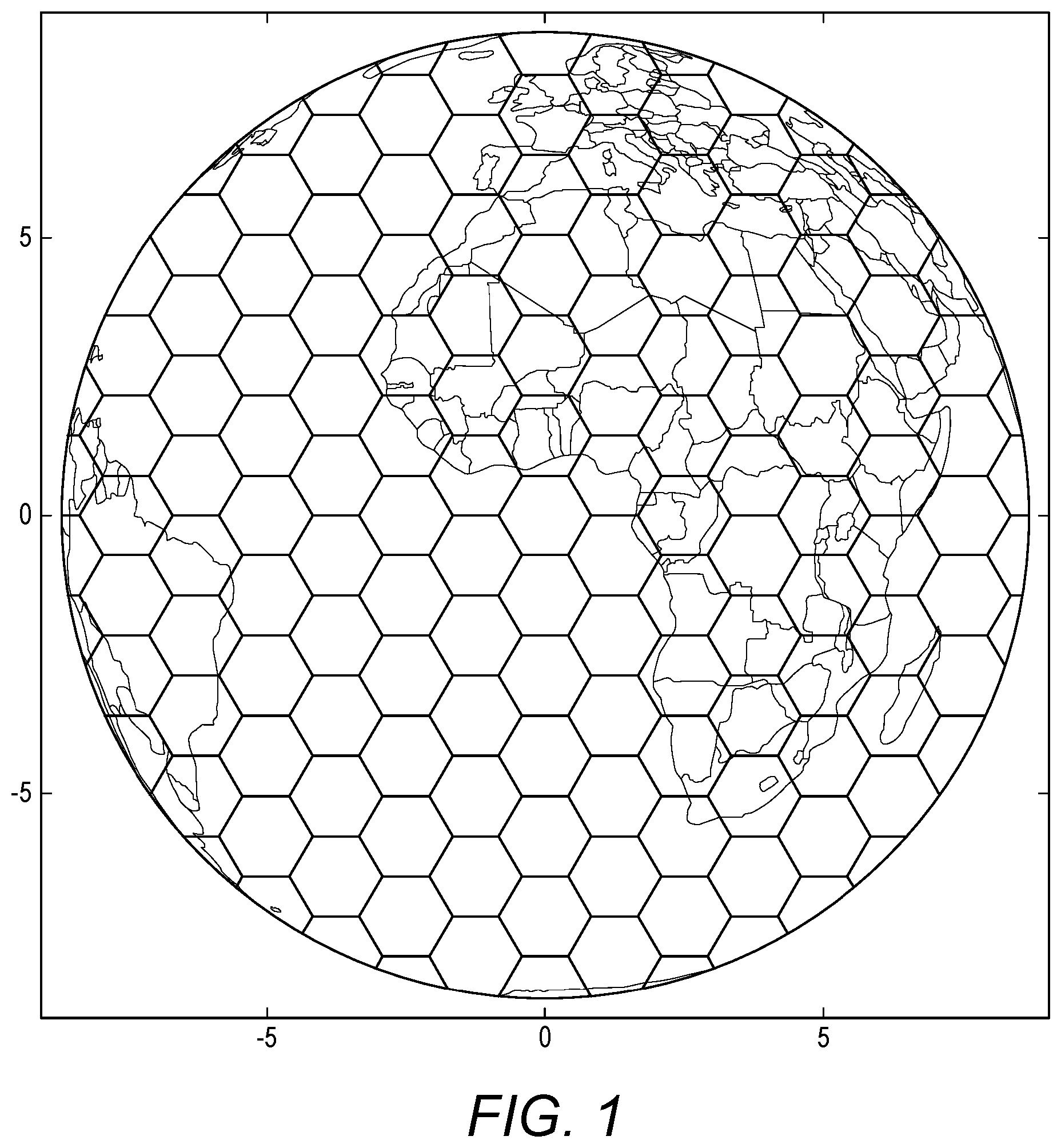
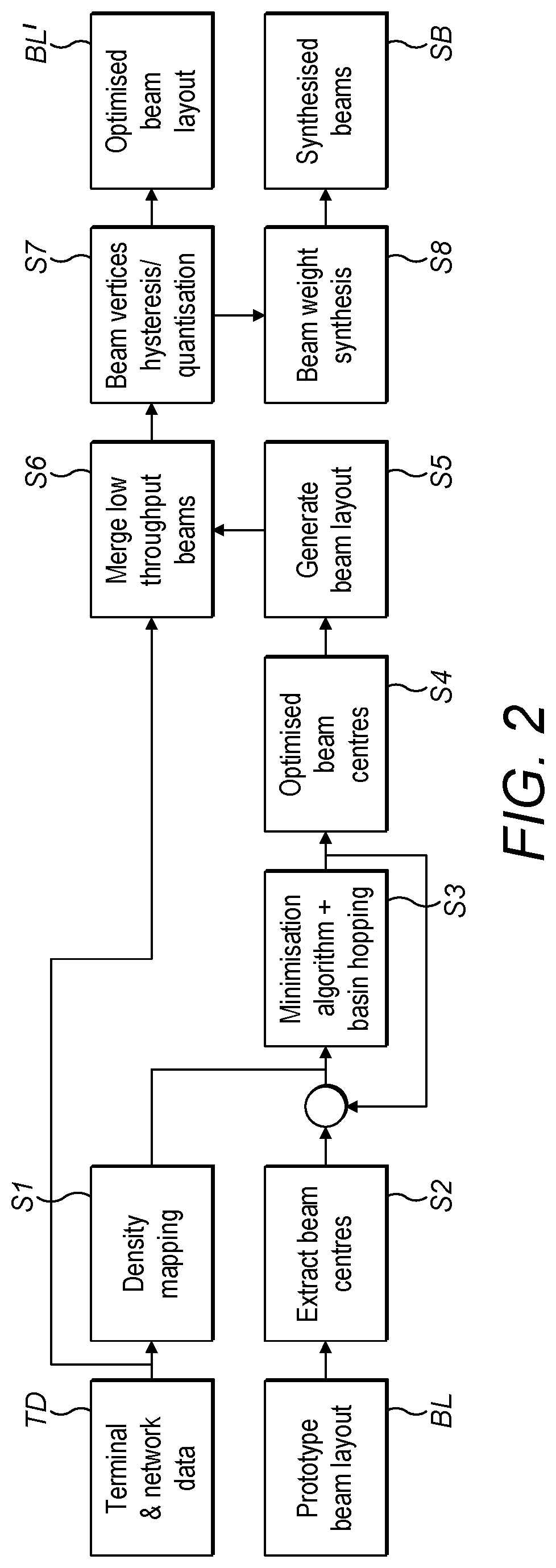
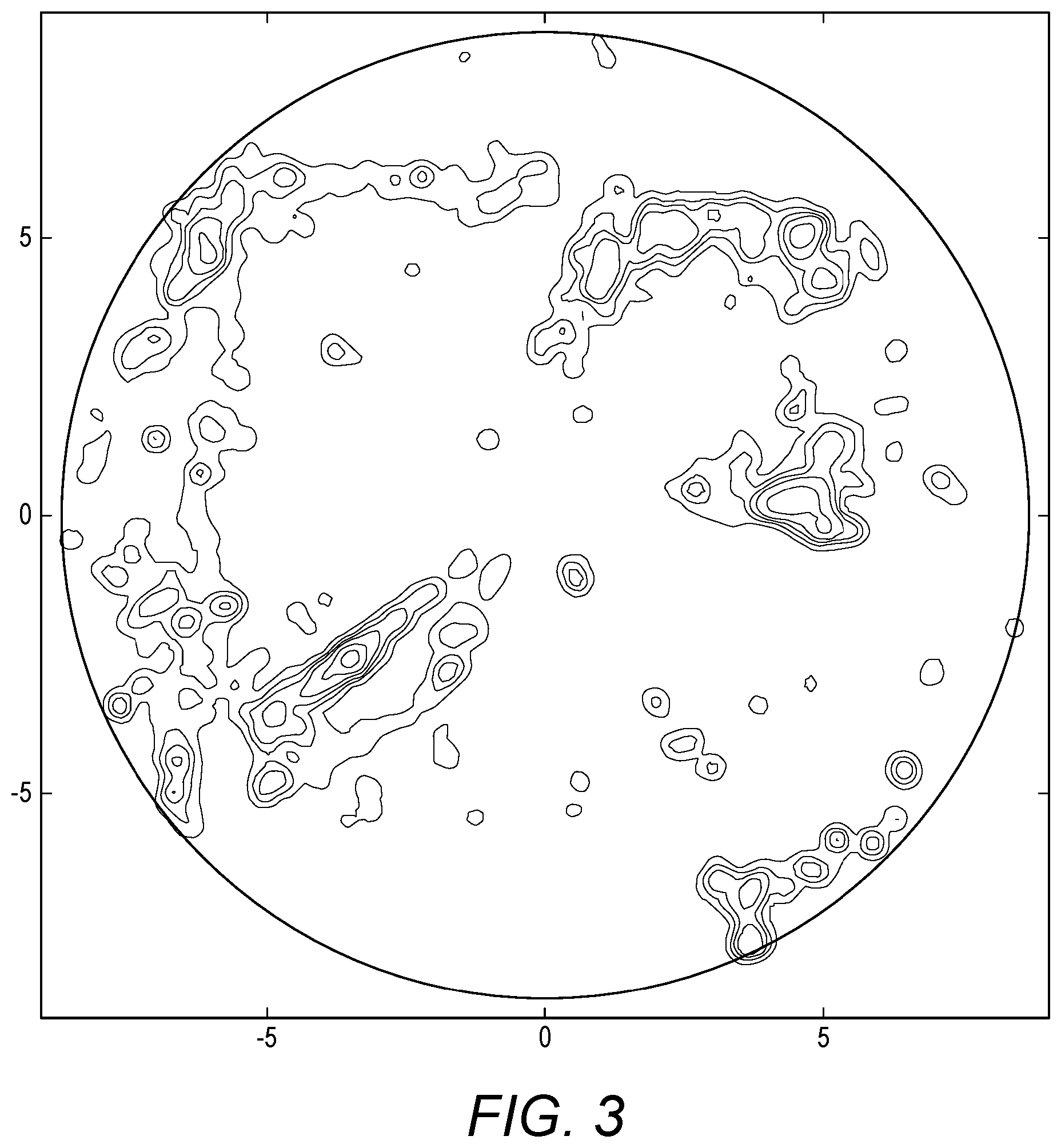
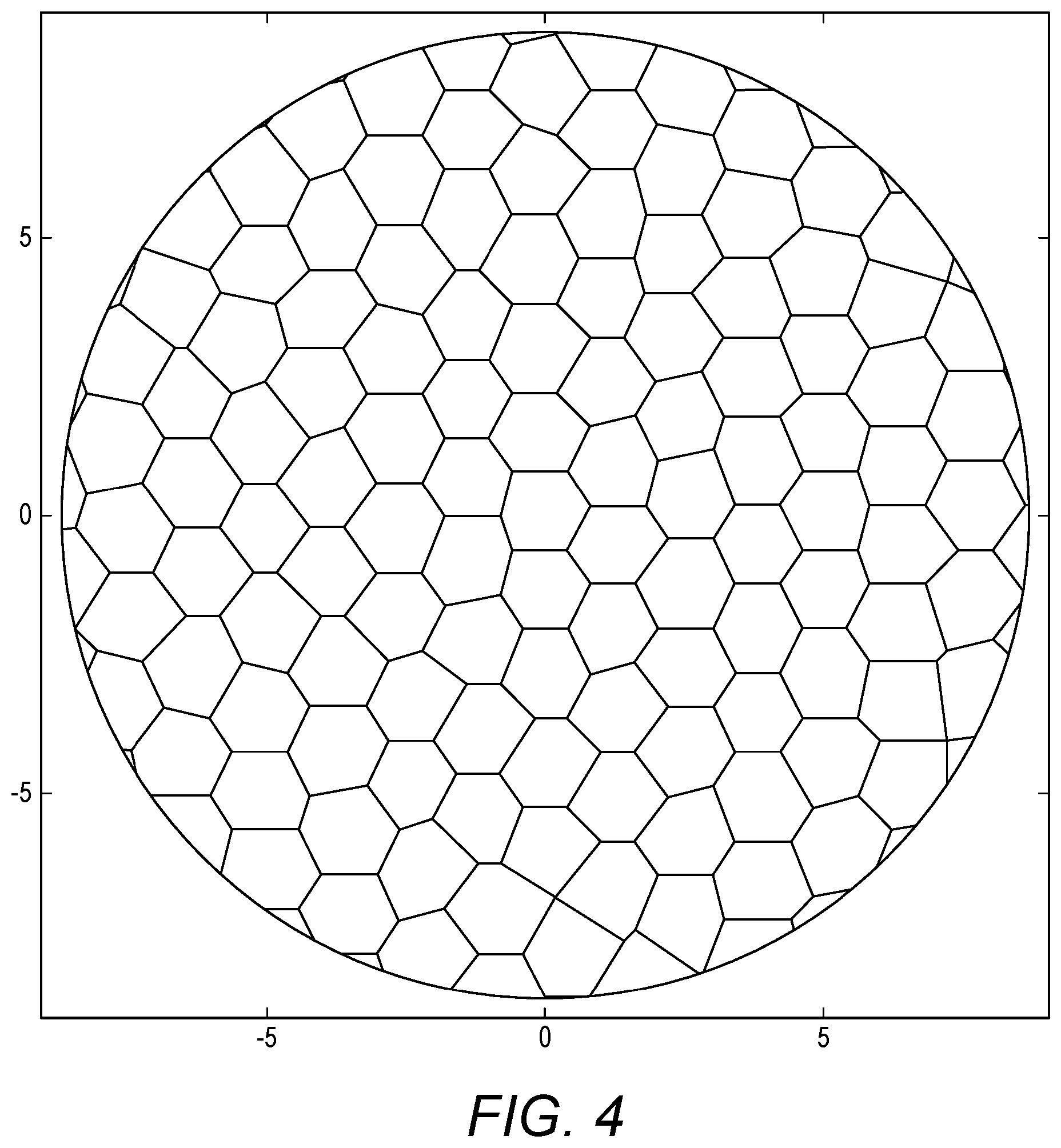
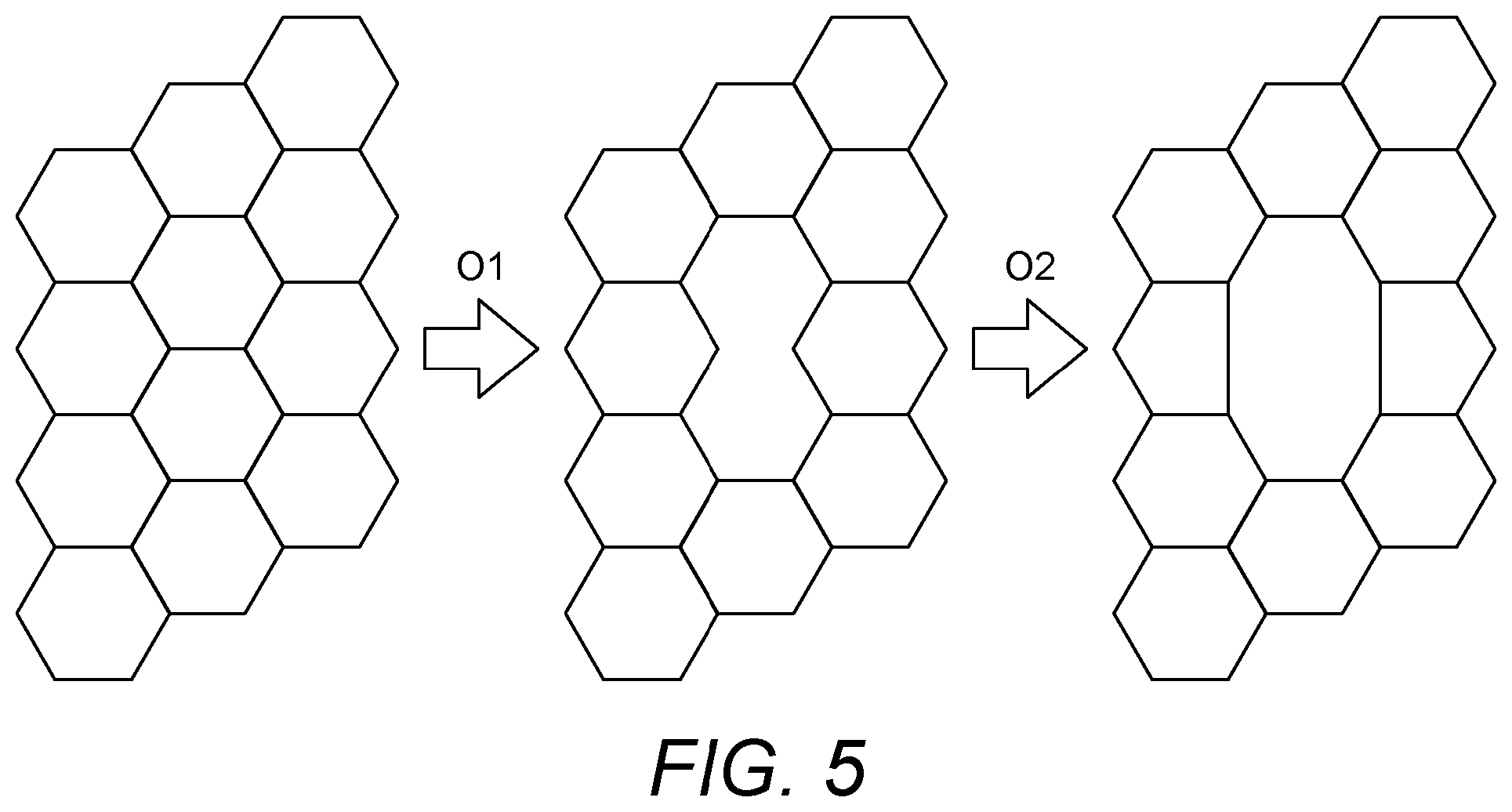
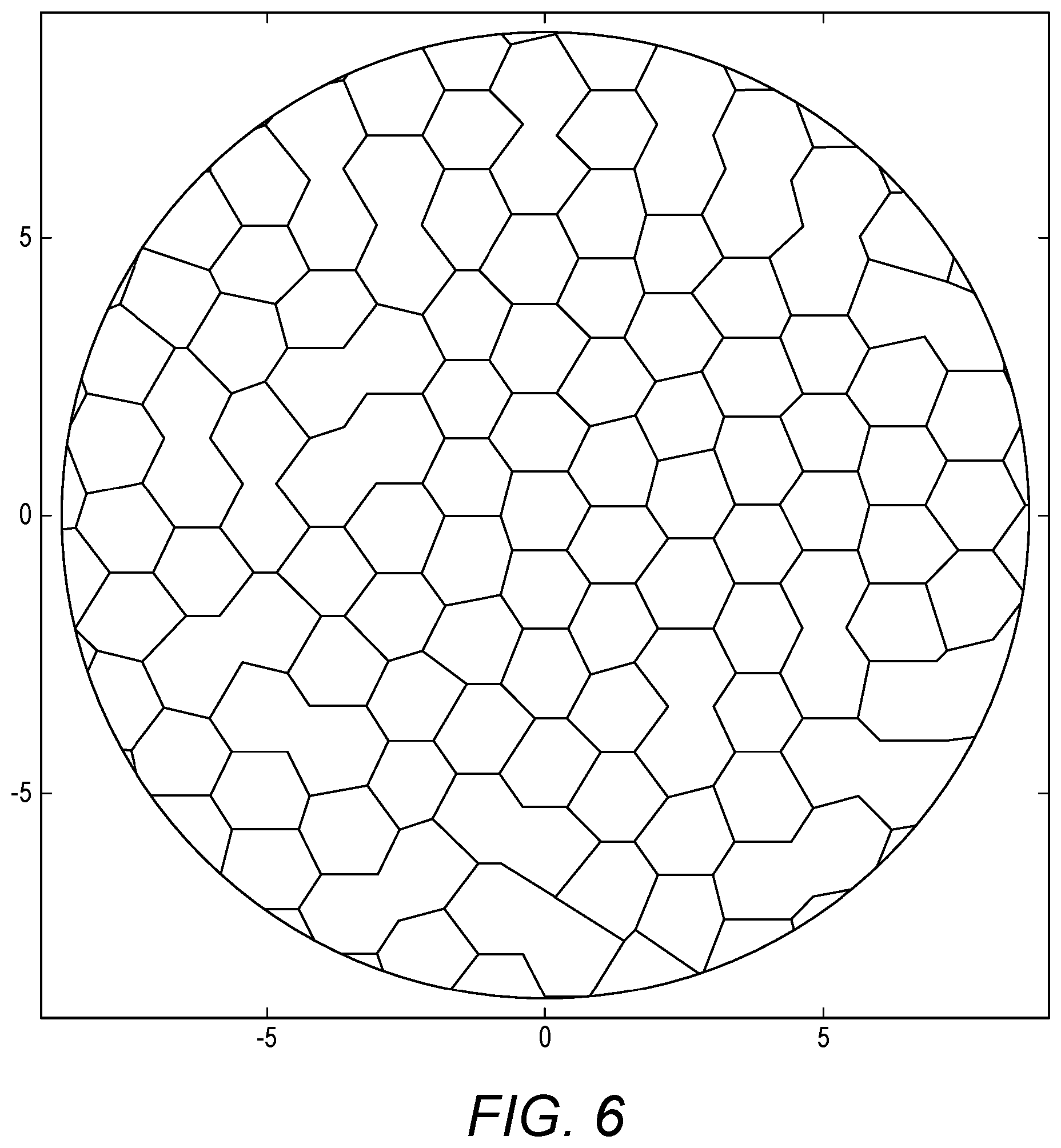




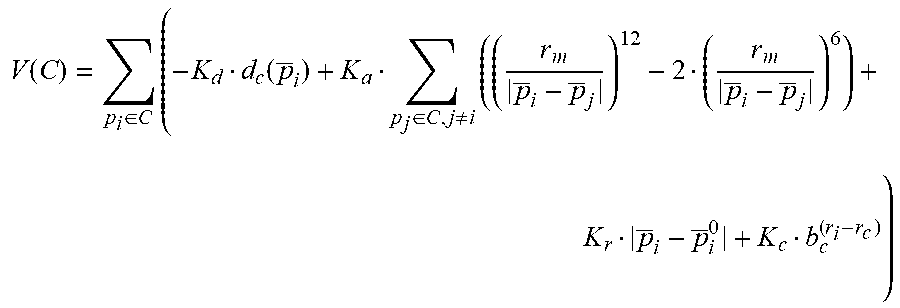
View All Diagrams
| United States Patent Application | 20200212996 |
| Kind Code | A1 |
| LIDDELL; Adam Alexander ; et al. | July 2, 2020 |
Beam Layout Optimisation
Abstract
A beam layout is optimised for a given traffic distribution and network state by determining optimum beam centre positions and generating a beam layout so as to meet system requirements and minimise the distances of locations within a coverage area from the optimum beam centre positions. Adjacent beams in low traffic areas may be merged.
| Inventors: | LIDDELL; Adam Alexander; (London, GB) ; BHAVE; Pavan; (London, GB) ; MOORES; Benjamin; (London, GB) | ||||||||||
| Applicant: |
|
||||||||||
|---|---|---|---|---|---|---|---|---|---|---|---|
| Family ID: | 59358146 | ||||||||||
| Appl. No.: | 16/621488 | ||||||||||
| Filed: | June 11, 2017 | ||||||||||
| PCT Filed: | June 11, 2017 | ||||||||||
| PCT NO: | PCT/GB2018/051588 | ||||||||||
| 371 Date: | December 11, 2019 |
| Current U.S. Class: | 1/1 |
| Current CPC Class: | H04B 7/2041 20130101; H04B 7/18513 20130101; H04B 7/1851 20130101; H04B 7/0408 20130101; H04B 7/18515 20130101 |
| International Class: | H04B 7/185 20060101 H04B007/185; H04B 7/0408 20060101 H04B007/0408 |
Foreign Application Data
| Date | Code | Application Number |
|---|---|---|
| Jun 12, 2017 | GB | 1709322.0 |
Claims
1. A method of generating an optimised beam layout for a satellite in a satellite communications system, the method comprising: a. receiving terminal and/or network data representing a distribution of communications terminals to be served by the satellite in the coverage area; b. optimising the positions of a set of beam centres with respect to the terminal and/or network data, to generate optimised beam centre positions; and c. outputting the optimised beam centre positions and/or optimised beam layout data representing an optimised beam layout derived from the optimised beam centre positions.
2. The method of claim 1, wherein the terminal and/or network data is represented by a density function.
3. The method of claim 1, wherein the step of optimising the positions of the beam centres comprises minimising a function.
4. The method of claim 3, wherein the function represents an attraction of the beam centres to regions of high parameter density.
5. The method of claim 3, wherein the function represents one or more constraints in the spacing between the beam centres.
6. The method of claim 3, wherein the function represents one or more constraints on distance of each beam centre from a previous position.
7. The method of claim 3, wherein the function represents containment of the beam centres within a given coverage area.
8. The method of claim 3, wherein minimising the function includes ensuring a global or near-global minimum.
9. The method of claim 3, wherein the function is a scalar function.
10. The method of claim 1, wherein the optimised beam layout data is derived from the optimised beam centre positions so as to minimise the distance of locations within the coverage area from the optimised beam centres.
11. The method of claim 1, including merging one or more adjacent beams in the optimised beam layout, to generate merged optimised beam layout data.
12. (canceled)
13. The method of claim 11, wherein the merged adjacent beams correspond to areas of low traffic.
14. The method of claim 11, wherein merging the one or more adjacent beams includes simplifying the geometry of the optimised beam layout.
15. The method of claim 1, including identifying one or more high traffic or high priority terminals from the terminal and/or network data and determining an overlay beam directed to the one or more high-traffic terminals.
16. The method of claim 15, wherein the traffic from the one or more high traffic or high priority terminals is removed from consideration of the optimised beam layout.
17. The method of claim 1, including quantising the optimised beam layout.
18. The method of claim 1, comprising iteratively performing the method of steps a. through c., wherein the terminal and/or network data varies with time.
19. The method of claim 18, including inhibiting changes to the beam layout falling below a threshold criterion.
20. The method of claim 1, including synthesizing a set of beam weights to match or approximate the optimised beam layout.
21. The method of claim 1, including generating the optimised beam layout.
22. The method of claim 1, including generating a set of beam patterns according to the optimised beam layout.
23. (canceled)
24. (canceled)
25. A system for generating an optimised beam layout for a satellite in a satellite communications system, the system comprising: a. an input arranged to receive terminal and/or network data representing a distribution of communications terminals to be served by the satellite in the coverage area; b. a processor arranged to optimise the positions of a set of beam centres with respect to the terminal and/or network data, to generate optimised beam centre positions; and c. an output arranged to output the optimised beam centre positions and/or optimised beam layout data representing an optimised beam layout derived from the optimised beam centre positions.
26. A computer program product comprising program code arranged to perform the following steps when executed on a processor: a. receive terminal and/or network data representing a distribution of communications terminals to be served by the satellite in the coverage area; b. optimise the positions of a set of beam centres with respect to the terminal and/or network data, to generate optimised beam centre positions; and c. output the optimised beam centre positions and/or optimised beam layout data representing an optimised beam layout derived from the optimised beam centre positions.
Description
FIELD OF THE INVENTION
[0001] The present invention relates to a method and apparatus for determining an optimised beam layout in a satellite communications system.
BACKGROUND OF THE INVENTION
[0002] In conventional phased-array satellite systems, such as the applicant's BGAN (Broadband Global Area Network) system operating over an Inmarsat-4 (I4) satellite, the coverage is provided by a beam layout comprising global, regional and/or narrow beams. Each beam may be specified as a weighted sum of the phased-array element beams and the beam weights and logical boundaries can be updated in response to events or requirements, such as for bespoke service coverage or interference management. Typically, this beam layout may be effectively static, with updates performed manually on a beam-by-beam basis.
[0003] A sample conventional beam layout of congruent beams is shown in FIG. 1, where the beam edges represent the logical beam coverage boundaries. A problem with a static beam layout of congruent beams is that it is typically only optimal for a uniform user and demand distribution; for non-uniform traffic profiles, regions of high throughput demand or user density may lie at the edge of a beam, where the system performance is typically degraded as compared to the beam centre.
[0004] In practice, the distribution of users and demand for a satellite system is almost always non-uniform and varies significantly with time. This distribution is typically composed of a number of high demand `hotspots` over populated areas, whilst other regions of the coverage remain largely unoccupied.
[0005] U.S. Pat. No. 5,754,139 discloses a beam forming system that is responsive to traffic demand, by providing additional antenna beams for areas of high traffic demand. The antenna beams are apparently shaped to optimize geographic coverage, but no consideration is given to the overall beam layout.
SUMMARY OF THE INVENTION
[0006] According to one aspect of the present invention, there is provided a method and system for optimising a beam layout for a given traffic distribution and network state by determining optimum beam centre positions and generating a beam layout so as to meet system requirements and minimise the distances of locations within a coverage area from the optimum beam centre positions.
[0007] The traffic distribution and network state may be mapped into a parameter density function based on the parameter or parameters that are being optimised for, such as user density or throughput demand. This parameter density function may be interpolated over the satellite footprint, to reduce computational complexity.
[0008] The optimised beam centre positions may be determined by minimising a function including one or more sub functions representing: [0009] the attraction of beam centres to regions of high parameter density; [0010] the behaviour of beam centres with respect to each other; [0011] a tendency to restore the beam centres towards their previous locations; and/or [0012] containment of the beam centres to a coverage area
[0013] The choice of minimisation method may be augmented with a basin-hopping step to ensure a global or near-global minimum is found.
[0014] An optimised beam layout may be derived from the optimised beam centres, so as to minimise the distance of locations within the coverage area from the optimised beam centres and to meet other system requirements or constraints. The optimised beam layout may be simplified, for example by quantisation to a predetermined grid.
[0015] Adjacent beams in areas with a low parameter density may be merged. The merging step may be carried out independently from the determination of optimum beam centre positions. Optionally the geometry of the beam layout after merging may be simplified.
[0016] Specific users or groups may be allocated a separate dedicated beam overlaid on the optimised beam layout, such as for high throughput or high priority users. These users may be removed from the general traffic distribution so that they do not affect calculation of the optimum beam layout.
[0017] The methods may be repeated, so that the optimised beam layout is continuously or periodically re-optimised according to the current traffic distribution.
[0018] A set of phased-array beam weights may be calculated by a beam weight generator so as to produce beam coverage patterns (Gain, EIRP, G/T, etc.) corresponding at least approximately to the optimised beam layout. The beam weights may be provided to a satellite beam former so as to generate the beam layout.
[0019] The method may be implemented by a computer program and/or suitably configured hardware or firmware.
BRIEF DESCRIPTION OF THE DRAWINGS
[0020] Specific embodiments of the present invention will now be described with reference to the accompanying drawings, in which:
[0021] FIG. 1 shows an example of a conventional satellite beam layout with congruent beams.
[0022] FIG. 2 is a flow diagram of the method of operation of an embodiment of the invention.
[0023] FIG. 3 shows the contours of an example density function mapped for a representative traffic distribution
[0024] FIG. 4 is a sample optimised beam layout in an embodiment.
[0025] FIG. 5 shows an example of beam merging in an embodiment.
[0026] FIG. 6 shows a sample merged beam layout in an embodiment.
DETAILED DESCRIPTION OF EMBODIMENTS
Definitions
[0027] Specific terms as used herein are defined as follows:
[0028] Beam Layout: This specifies the logical borders of a set of beams for a single satellite, defined by the polygon vertices in the satellite viewpoint/boresight projection. An example beam layout is shown in FIG. 1, however regions in the layout need not necessarily be served by exactly one beam and overlaps are possible.
[0029] Beam Pattern: The performance characteristics (EIRP, G/T, etc.) of a single beam over the satellite coverage area.
[0030] Overview
[0031] FIG. 2 shows an overview of a dynamic beam layout optimisation method and system according to an embodiment of the invention, with inputs at the left, processing steps in the centre and outputs to the right. The system/method takes as input a prototype beam layout or set of beam centres BL and terminal and network data TD and produces as output an optimised beam layout BL'.
[0032] The prototype beam layout may be such as shown in FIG. 1 or a prior output from the dynamic beams system/method according to the embodiment. Where the prototype beam layout is a prior output of the system/method, the conversion from centres to layout (step S5) and from layout to centres (step S2) may be skipped within the system/method.
[0033] The terminal and network data TD may be a continuously or periodically updated stream of information about the locations and parameters of all terminals within the network, in addition to the current state of network components.
[0034] As the terminal and network data TD is updated, the system/method can be run iteratively on the input data to provide a constantly optimised beam layout BL' for the present system state. In each iteration, the prior output beam layout BL' may be used as the input prototype beam layout BL for the current optimisation.
[0035] The system/method shown includes two logically distinct sub-systems/methods, each of which could be run in combination or separately for each satellite or coverage region: [0036] i. Beam Centre Optimisation: targets beam centres to regions of high parameter density (steps S1 to S5) [0037] ii. Beam Merge: coalesces adjacent beams to reduce unused resources (step S6)
[0038] The final beam-weight synthesis step S8 may be performed externally of the remainder of the system/method, for example using a common framework shared for all beam layout optimisation tasks across all services, to produce a set of synthesised beam patterns.
[0039] The individual steps of the system/method will be described in more detail below.
[0040] Density Mapping
[0041] At the density mapping step S1, satellite and ground network monitoring infrastructure provides terminal and network data TD for a set of M terminals at locations L={l.sub.1, . . . , l.sub.M}).OR right..sup.2, each with an associated weighting metric W={w.sub.1, . . . , w.sub.M}.OR right..sub..gtoreq.0, where |L|=|W|=M.di-elect cons..sup.+. The positions L are in a satellite viewpoint projection, such as shown in FIG. 1. The weighting metric sets the target optimisation parameter; this may, for example, be terminal data throughput, traffic priority, a combination of the above or a uniform weight w.sub.n=1 .A-inverted.n.di-elect cons. [1, M].
[0042] From these locations L and weights W, there is defined a density function d(x), d: M.sup.2.fwdarw.. As an example, this may be implemented as a weighted Gaussian kernel density estimation, with constant bandwidth .sigma.:
d ( x _ ) = k = 1 | L | ( w k e - | x - l k | 2 2 .sigma. 2 ) / w .di-elect cons. W w ##EQU00001##
[0043] This density function can be normalised to the range [0,1], to provide non-dependent component weights in the scalar function V defined later:
d n ( x ) = d ( x ) - min y .di-elect cons. 2 ( d ( y _ ) ) max y _ .di-elect cons. 2 ( d ( y _ ) ) - min y _ .di-elect cons. 2 ( d ( y _ ) ) ##EQU00002##
[0044] The density function may also be mapped by a function f.sub.c, to remove outliers and set a soft low threshold, as shown in FIG. 3. The example below is of a composite of a sigmoid function and fractional exponent, with the parameters {S.sub.e, S.sub.p, S.sub.c}.OR right..sub..gtoreq.0:
d c ( x _ ) = f c ( d n ( x ) ) = d n ( x _ ) 1 / S e 1 + e - S p ( d n ( x _ ) - S c ) ##EQU00003##
[0045] Any of these density functions d(x), d.sub.n(x) or d.sub.c(x) may be sampled and interpolated over the domain of the satellite footprint to reduce computational complexity in subsequent calculations.
Beam Centres Optimisation
[0046] From an input prototype beam layout, such as in FIG. 1, the beam centres are extracted in step S2 and optimised at step S3. The beam centres may, for example, be extracted via the geometric centroid of each polygon, giving a set of N beam centres C={p.sub.1, . . . , p.sub.N}.OR right..sup.2 where
p n = ( x y n ) and ##EQU00004## r n = p _ n = x n 2 + y n 2 ##EQU00004.2##
[0047] For these centres C, there is defined a scalar function V: N.sup.2.fwdarw.:
V ( C ) = p i .di-elect cons. C ( - K d d c ( p _ i ) + K a p j .di-elect cons. C , j .noteq. i ( ( r m p _ i - p _ j ) 12 - 2 ( r m p _ i - p _ j ) 6 ) + K r p _ i - p _ i 0 + K c b c ( r i - r c ) ) ##EQU00005##
[0048] This function is composed of four sub-functions, weighted by the configurable parameters {K.sub.d, K.sub.a, K.sub.r, K.sub.c}.OR right..sub..gtoreq.0. [0049] The component -K.sub.dd.sub.c(p.sub.i) contains the attraction of the beam centres to the regions of high parameter density in the density function d.sub.c. The density functions d and d.sub.n may be used alternatively. [0050] The component
[0050] K a p j .di-elect cons. C , j .noteq. i ( ( r m p _ i - p _ j ) 1 2 - 2 ( r m p _ i - p _ j ) 6 ) ##EQU00006##
dictates the behaviour of the beam centres in relation to one another and sets the neutral inter-centre spacing r.sub.m.di-elect cons..sub..gtoreq.0, which can be based on the performance capabilities of the satellite and network systems. The functional minimum of this component alone is a near hexagonal tessellation, similar to the beam layout shown in FIG. 1. [0051] The component K.sub.r--|p.sub.i-p.sub.i.sup.0| acts to restore the centre p.sub.i to its prototype location p.sub.i.sup.0 [0052] The component K.sub.cb.sub.c.sup.(r.sup.i.sup.-r.sup.c.sup.) soft restricts the beam centres to a radius r.sub.c, based on the exponent with base b.sub.c. This component may be replaced with alternative regional or coverage constraints.
[0053] The optimisation of the location of the beam centres is therefore reduced to minimising the scalar function V, to get the set of beam centres C':
C ' = { p 1 '' , , p _ N '' } = arg min C V ( C ) ##EQU00007##
[0054] With arg min defined as
X m = arg min X f ( X ) .revreaction. f ( X m ) = min X .di-elect cons. R f ( X ) ##EQU00008##
[0055] This minimisation can be implemented using standard minimisation methods and can achieve a large performance gain by exploiting the differentiability of the potential V, to allow the use of gradient descent type algorithms. Any of these minimisation algorithms may be combined with a basin-hopping implementation to ensure the global or near-global minimum is found.
[0056] The output C' can be fed back into the same minimisation algorithm, when new data (L', W') is available or when reconfiguring the coefficients {K.sub.d, K.sub.a, K.sub.r, K.sub.c}:
C '' = { p 1 '' , , p _ N '' } = arg min C ' V ( C ' ) ##EQU00009##
[0057] This iteration allows for continuous optimisation of the beam layout as the user and network demands evolve.
Beam Layout Generation
[0058] From each set of optimised beam centres (C', C'', . . . ), the new beam layout is generated at step S55. The method to map beam centres to a beam layout may be selected or designed based on the constraints of the satellite and network systems. To generate the beam layout with minimum centre distance for every location, the beam centres can be used in a Voronoi tessellation with a Euclidean distance metric. For example, FIG. 4 shows the resulting beam layout from the Voronoi decomposition of an optimised set of beam centres. The truncated beams at the edge of coverage may be further processed to meet coverage requirements.
[0059] Whilst the Voronoi method guarantees every location is covered by exactly one beam, alternative beam layout generation methods could be implemented that intentionally overlap beams and perform more extensive load/handover balancing in the areas of multiple coverage.
Beam Merge
[0060] As a second stage optimisation, sets of adjacent beams may be coalesced into larger beams, at step S6, where one channel in a large beam is more efficient than independent channels in each of the component narrow beams. This step primarily targets low-throughput regions, however beams may also be merged due to other network requirements. The thresholds and constraints for merging beams are dependent on the comparative beam performance differential between the large and narrow beams, which will determine the level at which the independent beams become more efficient.
[0061] FIG. 5 shows an example of first-order beam merging O1 on the hexagonal original beam layout from FIG. 1, followed by an optional geometry simplification O2 to simplify beam weight synthesis. Second or higher-order merging of the previously merged cells may also be implemented, subject to the same or similar set of constraints. FIG. 6 shows the merged results of the optimised beam layout in FIG. 4, with some second-order merges and no geometry simplification.
[0062] Whilst the above algorithm may be applied to beams with a single partially used carrier, the same method could be applied to the remaining capacity in multi-carrier beams, particularly if the low-throughput terminals are shifted to the merged beam. Additionally, the layout optimisation and beam merge systems do not intrinsically share any internal state, meaning that they do not necessarily need to be synchronised and may be run as two autonomous stages or independently disabled as necessary.
Quantisation & Hysteresis
[0063] Due to the inter-dependency between neighbouring beams, it may be desirable to quantise the beam layout polygon vertices to a suitably spaced grid or use hysteresis from previous layouts to reject insignificant changes in beam shape, as in step S7. This would reduce the numbers of beams patterns requiring recalculation when changes to the layout occur. Additionally, caching of the generated beam patterns may allow for quick reuse in the event a beam shape reverts to a previously calculated target pattern.
Overlay/Tracking Beams
[0064] Specific terminals or terminal groups may be allocated one or more carriers to provide a priority or dedicated service. These terminals or groups may be high-throughput, high-priority or otherwise selected from the general terminal population. In such cases, one or more `overlay` beams may be generated for these carriers, with the beam pattern aligned to give peak performance over the terminal or group location. These overlay beams would operate independently from the beam layout optimisation method and the locations and parameters for the selected terminals or groups should be removed from the optimisation inputs TD.
Beam Synthesis
[0065] The final step (S8) in applying a new beam layout is to synthesise the phased-array element beam weights to match or approximate each target beam's shape and RF characteristics, producing a set of beam patterns. This beam synthesis step S8 may be carried out by a separate functional entity, shared between different services on the same system, where interference and isolation can be managed. For example, the beam weights may be synthesized by a beam weight generator and provided to a beam former on a satellite so as to generate the set of beam patterns.
ALTERNATIVE EMBODIMENTS
[0066] Alternative embodiments of the invention may be envisaged, which may nevertheless fall within the scope of the accompanying claims.
* * * * *
D00000

D00001

D00002

D00003

D00004

D00005

D00006










P00001

P00002

XML
uspto.report is an independent third-party trademark research tool that is not affiliated, endorsed, or sponsored by the United States Patent and Trademark Office (USPTO) or any other governmental organization. The information provided by uspto.report is based on publicly available data at the time of writing and is intended for informational purposes only.
While we strive to provide accurate and up-to-date information, we do not guarantee the accuracy, completeness, reliability, or suitability of the information displayed on this site. The use of this site is at your own risk. Any reliance you place on such information is therefore strictly at your own risk.
All official trademark data, including owner information, should be verified by visiting the official USPTO website at www.uspto.gov. This site is not intended to replace professional legal advice and should not be used as a substitute for consulting with a legal professional who is knowledgeable about trademark law.